What Does the Symbol on the Indian Flag Mean? Change!
The Ashoka Chakra, featured in the center of the Indian flag, represents the eternal wheel of law and stands for perpetual motion and change.
It signifies progress and movement in life, reflecting India’s forward-thinking ethos. As an emblem of dharmic principles, it underscores the importance of righteousness and moral order.
Explanation The Ashoka Chakra is a 24-spoke wheel that is named after Emperor Ashoka, a great historical figure known for spreading Buddhism and peace. Each spoke of the Chakra has a symbolic meaning, collectively representing the 24 virtues that one should practice.
This includes love, courage, patience, and peacefulness, among others. It is derived from the Dharmachakra, which has a central place in Indian philosophy and religion.
- Historical Context: Represents the spread of Dharma (law and righteousness) by Emperor Ashoka.
- Cultural Significance: Symbolizes life in movement and death in stagnation.
- Philosophical Meaning: Encourages moral and righteous living as per dharmic principles.
Supporting Paragraph Emblazoned on the Indian flag, the Ashoka Chakra is not merely an emblem but a guiding force, inspiring the nation’s citizens to follow the path of truth, virtue, and justice, thereby contributing to the country’s growth and harmony.
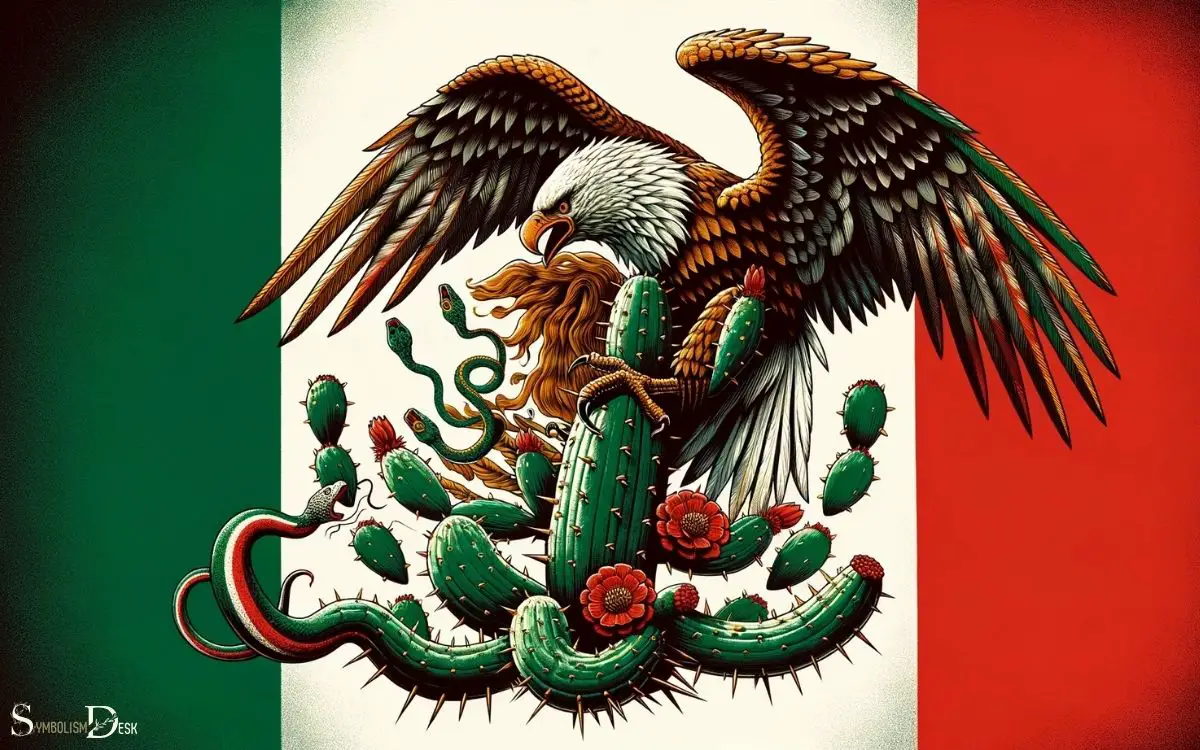
Key Takeaway
Historical Origins of the Ashoka Chakra
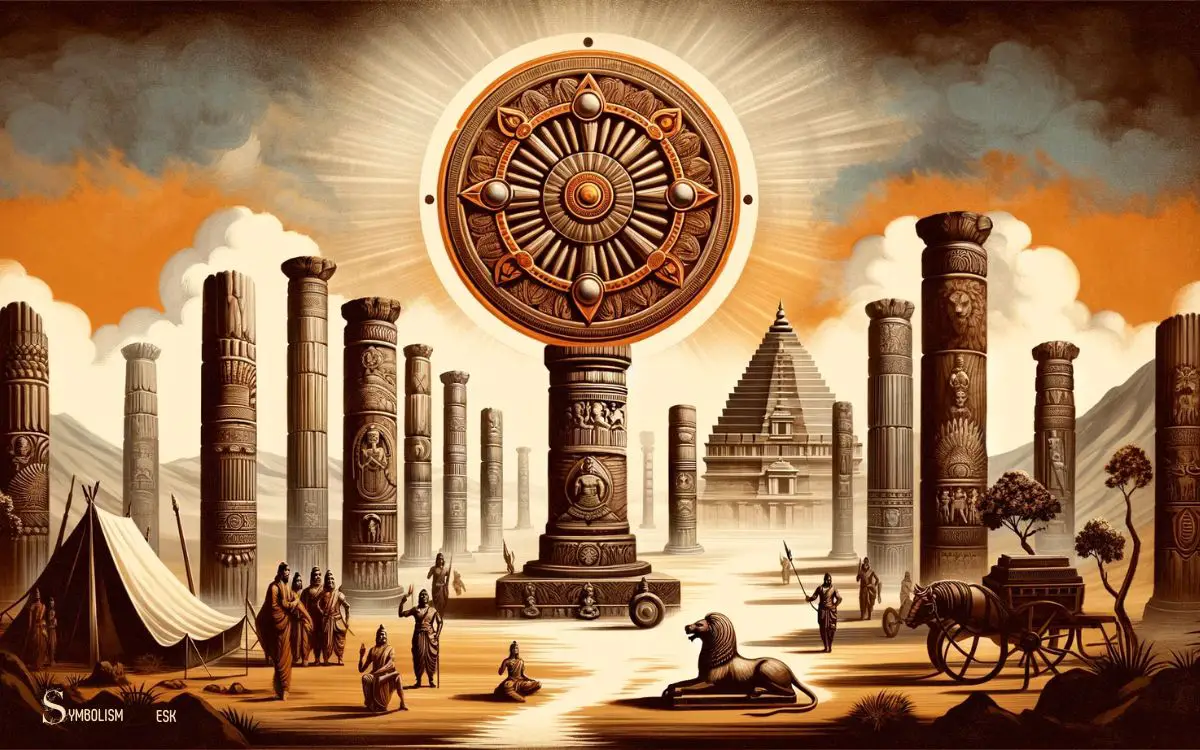
The historical origins of the Ashoka Chakra can be traced back to the time of Emperor Ashoka’s rule in ancient India. Emperor Ashoka, who reigned from 268 to 232 BCE, played a significant role in the spread of Buddhism and the Maurya Empire.
The Ashoka Chakra, also known as the ‘Wheel of Dharma,’ is a depiction of the Dharmachakra, a Buddhist symbol that represents the teachings of the Buddha.
It is said that Emperor Ashoka embraced Buddhism after witnessing the devastation caused by his military conquests.
The Ashoka Chakra on the Indian flag symbolizes the principles of truth, righteousness, and duty, which are integral to the teachings of Buddhism.
This ancient symbol continues to hold great significance in modern India, representing the country’s rich cultural and historical heritage.
Symbolism and Meaning of the Ashoka Chakra
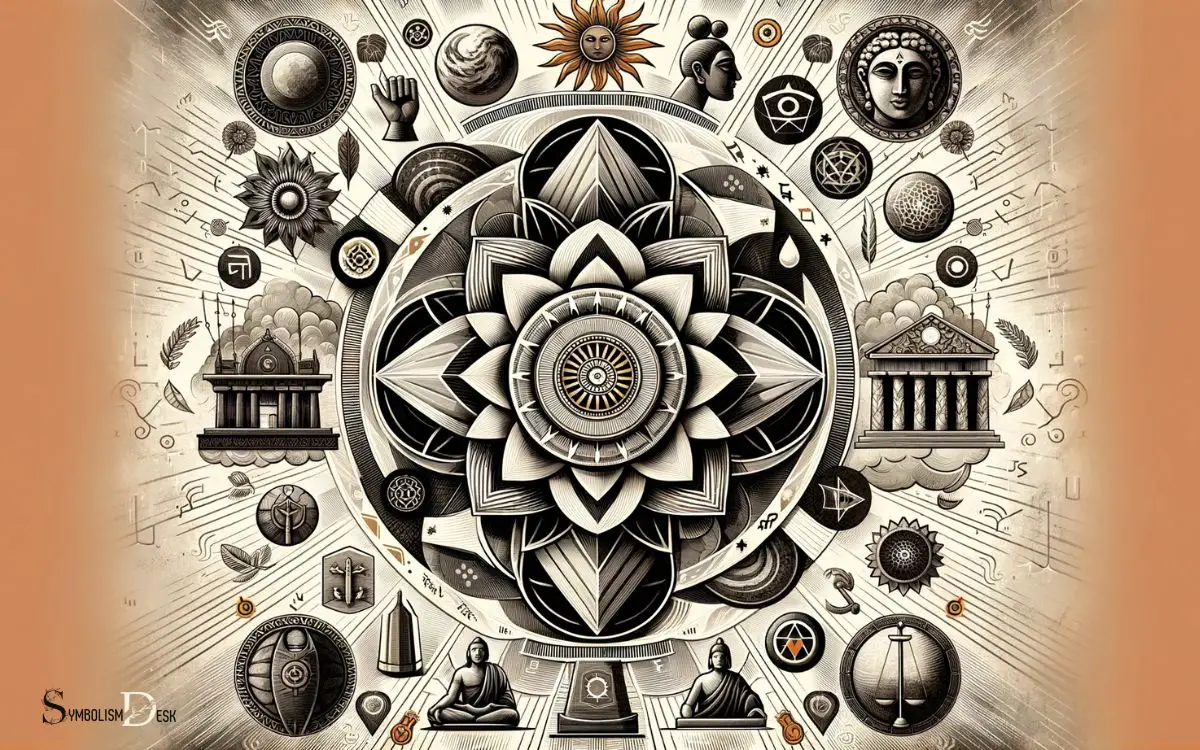
The Ashoka Chakra holds great significance in modern India and symbolizes the principles of truth, righteousness, and duty integral to the teachings of Buddhism.
Its symbolism and meaning can be understood through the following points:
- Dharma: The Ashoka Chakra represents the eternal law of dharma, emphasizing the importance of righteousness and moral values.
- Unity: It signifies the unity of the people of India and their resolve to strive towards progress and prosperity.
- Continuity: The 24 spokes in the chakra symbolize the endless cycle of life, death, and rebirth, representing the continuity of life and the interconnectedness of all beings.
- Progress: The chakra’s movement represents the dynamism and progress of the nation.
- Peace: It also signifies the pursuit of peace and non-violence, which are essential elements for the nation’s growth and stability.
Integration on the Indian National Flag
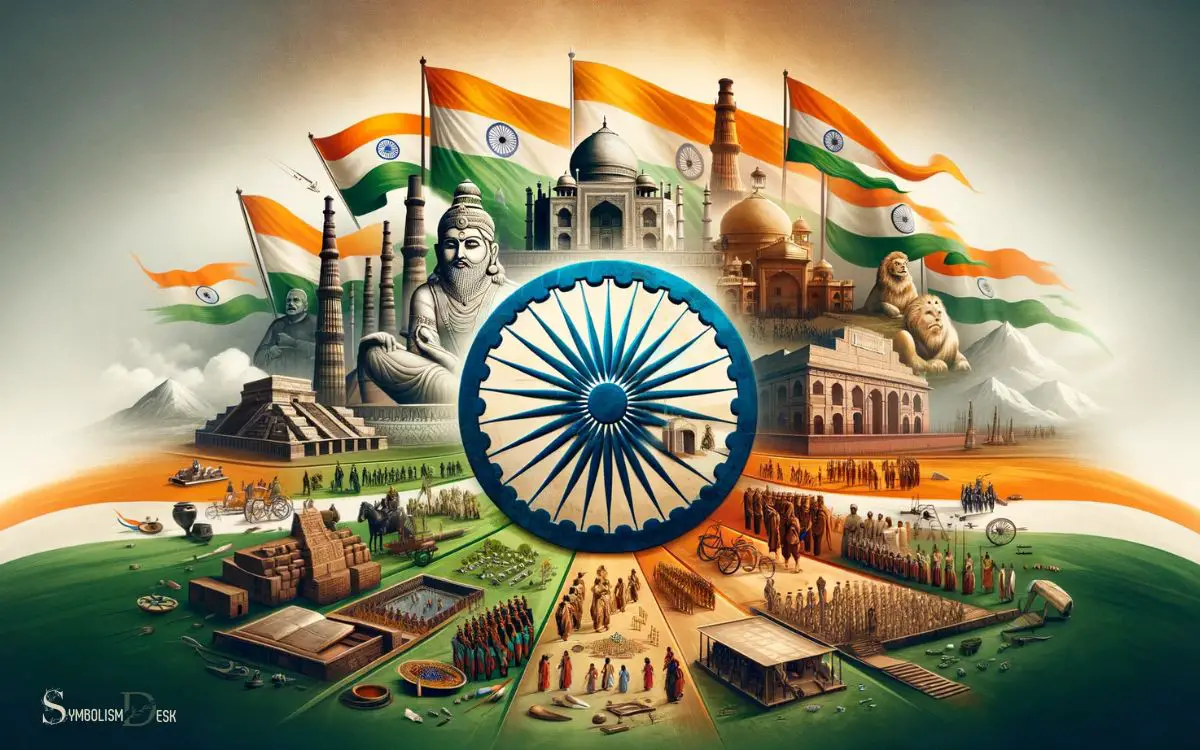
Representing the unity of India, the Indian National Flag integrates various symbols that hold deep historical and cultural significance. The flag consists of three horizontal stripes of saffron, white, and green colors.
In the center, it features the Ashoka Chakra, a 24-spoke wheel that symbolizes the eternal cycle of life and dharma. The saffron color represents courage and sacrifice, the white signifies truth and peace, and the green embodies faith and fertility.
These colors and the Ashoka Chakra together reflect the diversity and harmony within the nation. The integration of these symbols on the flag signifies India’s rich heritage, unity in diversity, and the aspirations of its people.
Below is a table summarizing the symbolism and meaning of the Indian National Flag:
| Symbol | Meaning |
|---|---|
| Saffron | Courage and sacrifice |
| White | Truth and peace |
| Green | Faith and fertility |
| Ashoka Chakra | Eternal cycle of life and dharma |
Significance in Indian Culture and Philosophy
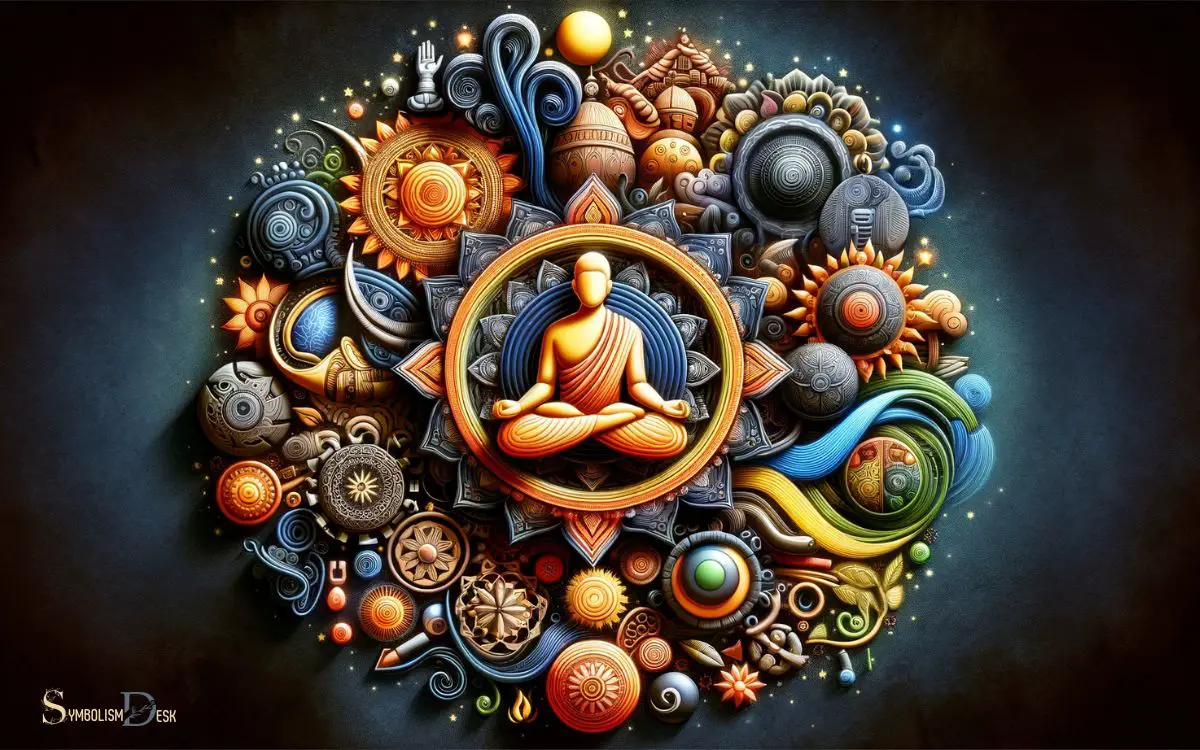
Integrated on the Indian National Flag, the symbols hold deep historical and cultural significance, resonating with the core values of Indian culture and philosophy.
- Dharma: The Ashoka Chakra represents the eternal law of righteousness, known as Dharma, which is a fundamental concept in Indian philosophy.
- Unity in Diversity: The tricolor flag symbolizes the diverse cultural and religious fabric of India, promoting unity amidst diversity.
- Non-Violence: The spinning wheel (Chakra) represents the Gandhian philosophy of non-violence and self-reliance.
- Courage and Sacrifice: The saffron color signifies the spirit of sacrifice, while the green represents growth, fertility, and auspiciousness.
- Truth and Peace: The white stripe stands for truth and peace, emphasizing the value of truth and peace in the Indian way of life.
What Is the Meaning and History Behind the Costa Rican Flag Symbol?
The costa rica flag symbolism throughout history carries significant meaning. The flag’s design features blue and white horizontal bands, representing the sky, opportunities, and purity. The central emblem depicts the country’s geography, with volcanoes, seas, and landmasses. The seven stars represent the seven provinces of Costa Rica. This flag showcases the nation’s commitment to peace, democracy, and unity, reflecting its rich history and progress.
What Does the Symbol on the Indian Flag Represent?
The symbol on the Indian flag represents the country’s rich history and cultural heritage. The “flag symbols in historical context” embody various elements, including chakra and lotus, representing peace, progress, and unity. These symbols hold deep significance, reflecting India’s journey towards independence and its diverse values and ideologies. Together, they symbolize the eternal spirit of the nation and its commitment to promoting peace, harmony, and progress. In addition to understanding India’s flag symbols, it is also important to grasp the significance of other national flags, such as Nepal’s. By understanding Nepal flag symbols, we can gain a deeper appreciation for the cultural and historical context of the country. Each symbol on a flag carries a unique and important meaning, and by understanding these symbols, we can foster greater understanding and respect for different cultures and their values.
Global Recognition and Influence

Globally, the symbol on the Indian flag is widely recognized and holds significant influence in various international contexts.
The Ashoka Chakra, a depiction of the wheel of law, symbolizes righteousness, progress, and perpetuity. Its presence on the Indian flag signifies the country’s commitment to justice, truth, and the continuous movement towards growth and development.
The symbol is not only revered within Indian culture but also resonates with people worldwide, representing India’s rich history, cultural diversity, and its contributions to global civilization.
It has become a widely acknowledged emblem of India’s principles and values, and it holds sway in international arenas, symbolizing India’s role as a democratic, progressive, and culturally significant nation.
As a result, the Ashoka Chakra on the Indian flag continues to wield influence and garner respect on the global stage.
Conclusion
The symbol on the Indian flag, the Ashoka Chakra, holds deep historical, cultural, and philosophical significance. Its origins and meaning reflect the values and aspirations of the Indian nation.
The integration of the Ashoka Chakra on the national flag represents unity and progress. Its global recognition and influence showcase the rich heritage and symbolism of Indian culture.
The Ashoka Chakra continues to inspire and resonate with people around the world, transcending geographical boundaries. Through its symbolism and history, the Ashoka Chakra captivates the hearts and minds of all who behold it.






